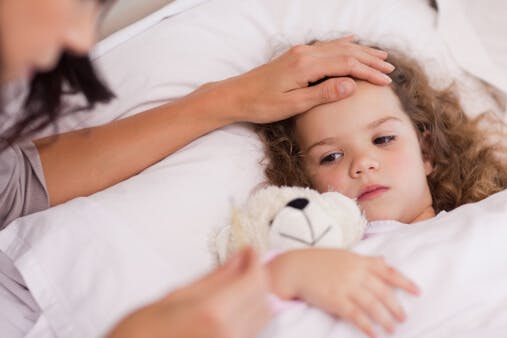Treating Febrile Seizures

Question
What’s the best thing to do for a child who’s having a febrile seizure?
Dr. Greene's Answer
During the seizure, leave your child on the floor, although you may want to slide a blanket under him if the floor is hard. Move him only if he is in a dangerous location. Loosen any tight clothing, especially around the neck. If possible, open or remove clothes from the waist up. If he vomits, or if saliva and mucus build up in the mouth, turn him on his side or stomach. Don’t try to restrain your child, or stop the seizure movements. Don’t try to force anything into his mouth to prevent him from biting his tongue, as this increases the risk of injury and choking. Be sure that your child is breathing during the seizure. If he appears blue around his lips or the seizure lasts for more than a few minutes, you should call 911 immediately.
Focus your attention on bringing the fever down. Inserting rectal acetaminophen (Tylenol) is a great first step — if you happen to have some. Don’t try to give him anything by mouth.
Apply cool washcloths to the forehead and neck. Sponge the rest of his body with lukewarm (not cold) water. (Cold water or alcohol may make him shiver and make the fever worse). After the seizure is over and your child is awake and alert, give him the normal dose of ibuprofen (Motrin or Advil) or acetaminophen (Tylenol) if you haven’t already done so. Children should see a doctor as soon as possible after their first febrile seizure. If the seizure ends quickly, drive him to an emergency room when it is over. If the seizure lasted several minutes, call 911 to have an ambulance bring him to the hospital.
After the seizure, the most important step is to identify the cause of the fever. Most febrile seizures are brought on by fevers arising from viral upper respiratory infections, ear infections, or roseola. Meningitis causes less than 0.1% of febrile seizures but should always be considered, especially in children less than one year old or who still look ill when the fever drops.
About one third of the children who have had a febrile seizure will have another one with a subsequent fever (about 2/3 won’t). Of those who do, about half will have a third seizure. Few have more than three. Sometimes febrile seizures run in families. If there is a family history, if the first seizure happened before 12 months of age, or if the seizure happened with a fever of <102, a child is more likely to fall in the group that has more than one febrile seizure.
To try to prevent future febrile seizures, many health care providers recommend using acetaminophen (Tylenol) and/or ibuprofen (Motrin or Advil) at the first sign of a fever. However, researchers have found that these medications may not necessarily prevent febrile seizures. Despite the question of their utility in preventing febrile seizures, these medications can make children more comfortable when they are feverish and are worth trying for that reason (Eur J Pediatr (2008) 167:17–27).
Other things to try include sponging your child with lukewarm water. Also give him cool liquids to drink — both to lower the temperature and to keep him well hydrated. Since febrile seizures can occur as the first sign of illness, prevention is often not possible. Neither an initial nor a recurrent febrile seizure suggests second-rate care of your child.
Sometimes children who have had a febrile seizure are subsequently treated by their parents as weak or vulnerable children. This does not help anyone. Simple febrile seizures should not hold a child back from his normal activities.


